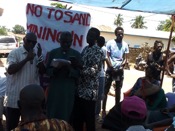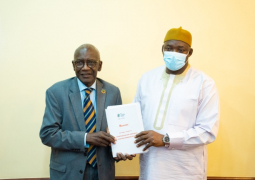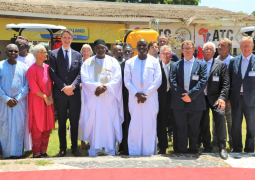
The Village Development Committee (VDC) in a meeting on Saturday 24 September says the birthrights of citizens of Kartong have been infringed upon and totally disregarded by denying them the token of “our village royalties. We are still grappling with the destruction of our once beautiful habitat enriched by our wonderful sand dunes accumulated overtime spanning centuries.”
The Gambia government through the Ministry of Lands has reserved about 200 metres from the Atlantic Ocean as a Tourism Development Area (TDA). However, mining companies have been licenced to mine the territory in some communities such as Kartong and Sanyang villages.
Kartong VDC had previously warned the Geology Department not to grant mining licence to any company to mine its territory.
Following this call, the VDC addressed a letter to the National Environmental Agency (NEA) and several mining stakeholders reaffirming its commitment to protecting their environment from degradation.
After the letter, the VDC held a community meeting aimed at updating Kartong residents on its stance on the suggested mining.
Reading the letter addressed to NEA before residents on Saturday 24 September, Momodou Lamin Touray, secretary general to Kartong VDC said: “We are aware that the government has reserved all coastlines in the Kombos for the development of tourism and calls it Tourism Development Area (TDA).
“Now, it seems the same Government is encouraging companies to destroy the same TDA through mining, be it sand or ilmenite.”
According to him, The United Nations Environment Programme (UNEP), World Tourism Organisation (WTO), Gambia Tourism Board (GTB) and Kartong Association for Responsible Tourism (KART) have identified Kartong as an Eco-Tourism area.
“This means Kartong was to promote environmental conservation to directly benefit the community through sustaining the continual arrival and departure of tourists. Could this be achieved with a totally destroyed environment,” he rhetorically asked, adding it is unfortunate.
Moving forward, he said, the magnitude and intensity of environmental damage and landscape destruction caused by the “recklessness and unacceptable sand mining from 1996-2000 and their subsequent mines have been catastrophic for the community.”
Touray noted the scars of environmental destruction caused by sand mining in Kartong are rampant but added that the community would no longer afford further damages in its territory.
“We as a people cannot tolerate more environmental crime any longer,” he noted.
In this regard, he said, the residents of Kartong believed that they should close ranks in an organised level to seek redress, reparation and claim damage from the central government.
SG Touray justified that before the mining, the Geology Department had promised to ensure that mine sites were backfilled after mining, sites are fenced, rehabilitated and the community to be compensated but none of these assurances were fulfilled.
Reacting to this, Alkinky Sanyang, senior education & communication specialist for NEA, noted that the quarries (mining sites) are not under the NEA, saying the environmental agency is only mandated to do environmental assessments and give clearance to mining companies.
“If any company requests for mining or to do anything with mining, it has to be first cleared by the Geological Department and that is the time we (NEA) say we need to do an environmental assessment and clearance is given,” he stated.
He added that NEA is not mandated to issue mining licences to mining companies but only does environmental assessment impact and gives clearance if certified.
However, he noted that if the Geological Department does not give certificates to a company, then NEA will not do any environmental assessment.
However, a government source confirmed to The Point that Gam Quarry Mining and General Trading Company is yet to be licenced to mine at Kartong.
Kartong is an ancient village located on a tropical valley bordered by the beach of the Atlantic Ocean on the west and meandering Halahein River on the east and south.





